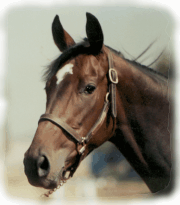|

|
A
Horse, Of Course
by Don Blazer |
I’ve
met some heroes.
Some wear a tiny bell so the blind can find them.
Some are the blind who seek them.
Some are staff or volunteers.
All the heroes have taken up the sword against the most formidable
enemy of all…..the enemy within each of us who yells, “I
can’t.”
I’ve said time and again, “If you can conceive it, you
can achieve it.” But I’ve never had to struggle to prove
it. I’ve never even had a difficult time. Everything for
me has been easy.
But it isn’t easy for the heroes.
Some heroes watch day after day after day as their children struggle
with physical disabilities. I try to comprehend, but I can’t
truly know the heartache they must feel, or the courage it takes
to begin another day. Some heroes are children inflicted with
disabilities. You can’t
tell them why they must suffer the pain, or the torment of trying
to do what for me is the simplest thing, but for them is a monumental
task.
How does a child who can’t control her arms or hands brush
a horse or hold on to the lead rope, or reach through the pipe
pen to touch?
She does it with pure desire born of love. She never says, “I
can’t.”
And why do some horses understand the child’s needs, patiently
wait, carefully carry and tenderly offer themselves. These horses
are heroes who in most cases also have physical impairments. Is
that why they so quickly connect?
Camelot therapeutic riding center says it is “where heroes
are born.”
I think it is where the heroes meet to do the incredible things
they do.
Eileen Szychowski, the founder and director, is a former rehabilitation
counselor and National Park Ranger who has dedicated herself to
this work for more than 20 years.
She
is a disabled equestrian.
Camelot
she says is a bridge leading to a life of freedom and self-fulfillment
for children or adults with physical disabilities.
“We
use horses and horsemanship as a means of therapy to improve strength,
balance, coordination and self-esteem.”
Using
the horse as a metaphor of life, Szychowski explains, students
learn to become stronger than the obstacles in their paths.
The
Camelot program is one-on-one with each student. The lessons are
based on the student’s unique abilities and needs. Our students
go through a demanding educational curriculum in horsemanship,
says Szychowski.
“We
teach every facet of equitation and the students accept the responsibilities
of horsemanship and care.”
In spite of blindness, paralysis, amputation or hearing impairment
many Camelot students eventually own their own horse.
Szychowski
says each horse in the program is trained to accept adaptive equipment
and spastic movements, and the horse’s training goes on throughout
his stay at Camelot.
There
are hundreds of such programs around the country, and thousands
of therapeutic riding horses.
I’ve
met just a few of the heroes and they’ve shown me the courage
of the heart which says, “I can.”
*****************************************************************
Read,
ride, reason. Visit www.donblazer.com
for answers to your questions about horses.
.







